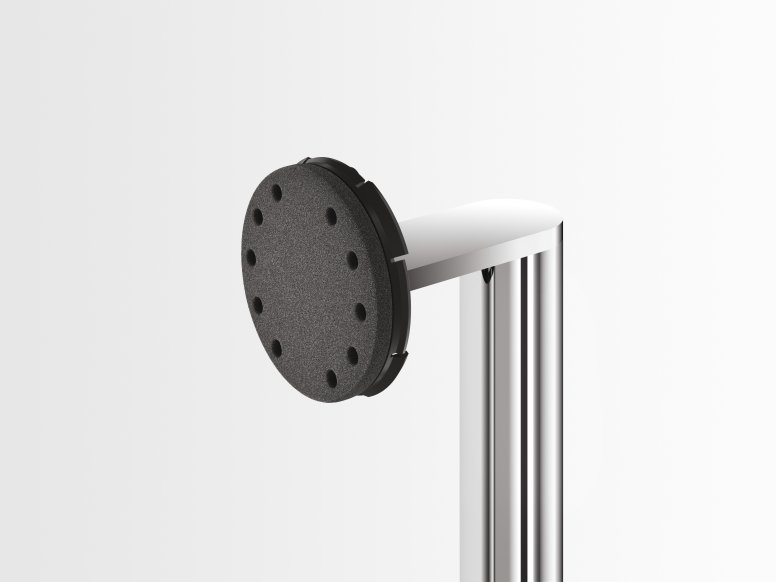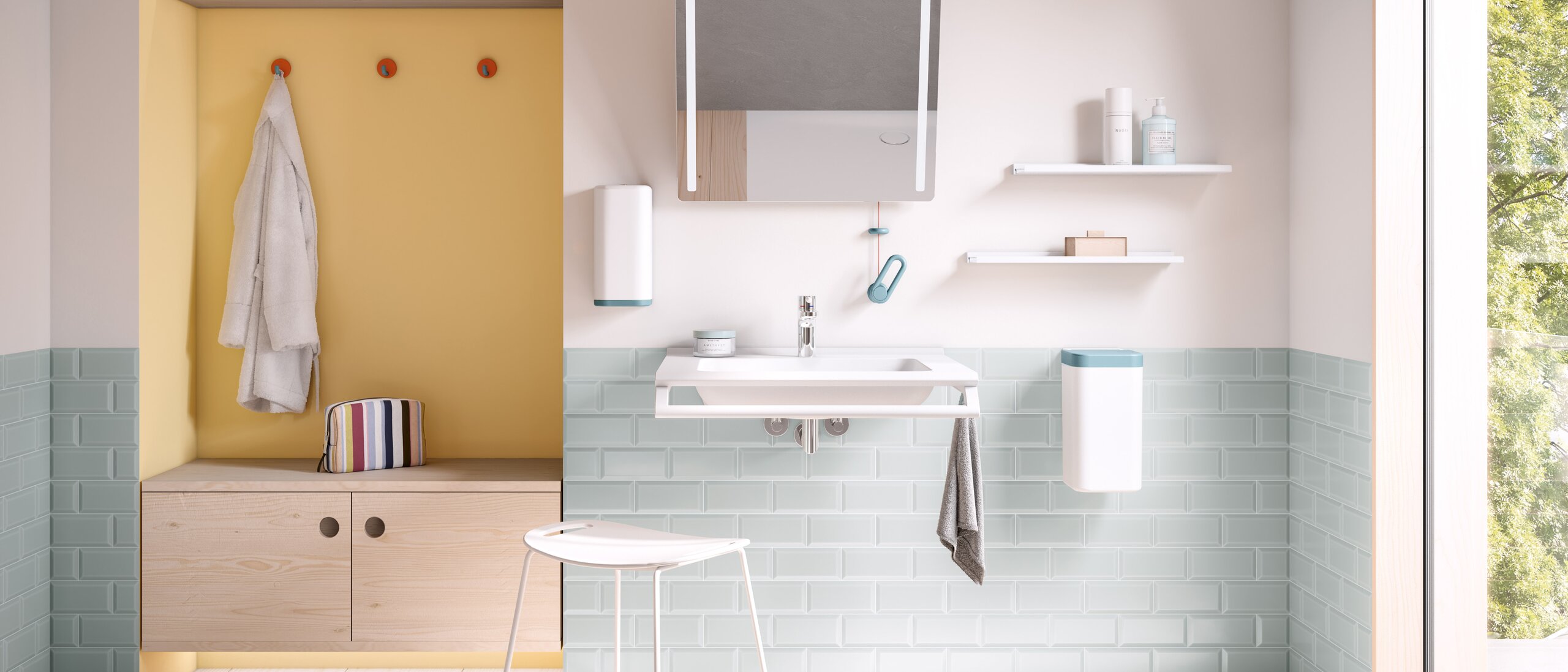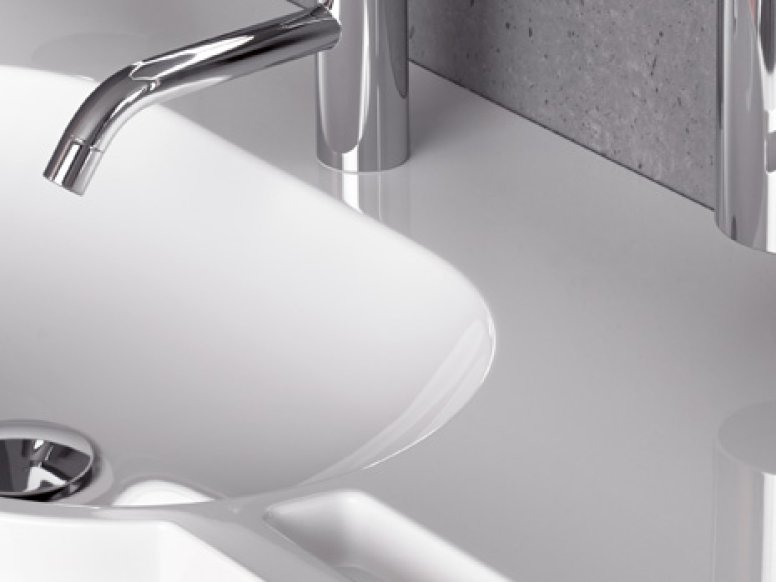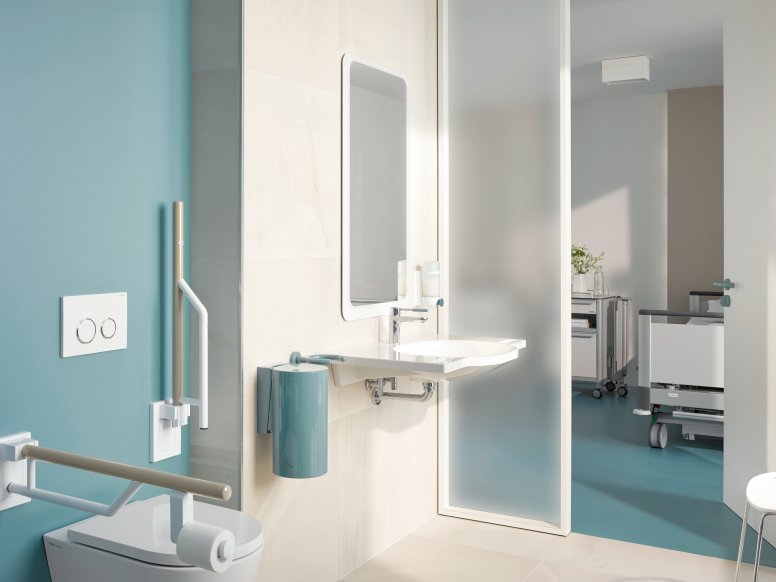HEWI MAG / Knowledge
Waterproofing in the bathroom: DIN 18534 – Waterproofing interiors according to standards
Proper waterproofing in the bathroom plays a crucial role in preventing damage to the structure and potential moisture problems. DIN 18534 is a standard that was developed specifically for waterproofing buildings indoors. In this article, we look in detail at the requirements and provisions of DIN 18534. The aim is to give you a comprehensive understanding of how to properly waterproof a bathroom.

INTRODUCTION TO DIN 18534
DIN 18534 is a standard developed by experts and professionals from the building industry. In 2017, it replaced the ten-part standard DIN 18195 and has since defined the requirements and specifications for building waterproofing indoors, particularly with regard to bathrooms. The aim of the standard is to ensure that waterproofing measures are carried out professionally and to a high standard of quality in order to prevent damage caused by moisture penetration. Compliance with DIN 18534 prevents structural damage and increases the service life of the structure.
DIN 18534: Differences between private and commercial rooms
DIN 18534 specifies which type of waterproofing is to be used in commercially used kitchens and bathrooms or shower facilities in the private sector. In addition, DIN 18534 regulates the use of waterproofing materials in sheet form and in liquid form as composite waterproofing under ceramic coverings. Both the established composite waterproofing and the system test certificates required for it are clearly defined. This certificate had previously applied only to buildings in the public sector. But now it must also be provided in the private sector.
WATERPROOFING IN THE BATHROOM: APPLICATION AND SCOPE
DIN 18534 applies to waterproofing in various areas of the bathroom such as showers, bathtubs, washbasins, and toilets. It covers new buildings as well as refurbishment and renovation projects. The standard refers to different substrates such as concrete, masonry, plasterboard, and tiles. Depending on the type of waterproofing, different requirements are specified in DIN 18534. This also includes specifications for the materials and products used.
REQUIREMENTS OF DIN 18534
DIN 18534 consists of six parts. These regulate the waterproofing of floor and wall surfaces with a maximum water accumulation height of 10 cm. It defines various protection classes that place different requirements on the waterproofing depending on the stress and use of the bathroom. For example, Protection class I applies to rooms with a low moisture load such as guest bathrooms. At the other end of the spectrum, Protection class III is suitable for rooms with a high moisture load such as showers or saunas. The standard specifies requirements for the pre-treatment of the substrate, the selection of the correct waterproofing systems, and the professional execution and testing of the waterproofing. It ensures that the waterproofing provides the necessary protection against moisture and remains functional in the long term.
WATER EXPOSURE CLASSES OF THE WATERPROOFING STANDARD
In addition to bathrooms and showers in the private sector and commercial kitchens, this also includes swimming pool walkways and floor areas with drains. Within DIN 18534, the intensity of the water impact is divided into four classes. These are based on how strongly and frequently that part is exposed to water. A distinction is also made between three crack classes and three joint types from which the waterproofing construction can be derived. Permanent waterproofing and conformity to standards are quite important in the sanitary sector. Waterproofing in the bathroom should therefore also be able to withstand an intended period of use. For a privately used bathroom, this means a period of about 20 to 25 years. The DIN also includes the protection of areas adjacent to sanitary rooms.
The water impact classes of the waterproofing standard
With DIN 18534, the water impact classes W01-I to W3-I were introduced at the same time
| Water impact class |
Application |
|---|---|
|
W0-I (low) Surfaces that are rarely exposed to splashing water |
|
|
W1-I (moderate) Surfaces that are frequently exposed to splashing water. Service water does not have a more frequent effect, no intensification because of standing water |
|
|
W2-I (high) Surfaces on which both splash and service water act more frequently. Water accumulates at least temporarily on the floor |
|
|
W3-I (very high) Surfaces that are exposed to splash and/or service water frequently or for long periods. Water from intensive cleaning processes, intensified by accumulating water |
|
PLANNING AND EXECUTION
Planning a waterproofing system in the bathroom in accordance with DIN 18534 requires a careful analysis of the substrate, the stress, and the environmental factors. Appropriate waterproofing systems that meet the requirements of the respective protection class must be selected. When carrying out the waterproofing work, professional and expert implementation is highly important. This includes the correct preparation of the substrate, the application of the waterproofing materials in accordance with the manufacturer’s instructions, and the assurance of a secure bond between the different layers of waterproofing.

WATERPROOFING THE SHOWER WITH SEALING TAPES
In the bathroom, the areas around the shower and bathtub are particularly sensitive. Silicone joints provide insufficient sealing. Sealing tapes should be used instead. As described above, the shower area is assigned to water impact class W2-I. However, the class differentiates according to whether there is a floor-level shower or a shower tray. The entire area of a floor-level shower falls into classification W2-I. In contrast, the areas around a shower tray fall under water impact class W1-I. When planning, you should therefore take into account which class the areas around the shower and/or tray fall under.
WHICH SEALS ARE SUITABLE FOR STANDARDISED WATERPROOFING?
In order to comply with the standard, installation parts that interrupt or penetrate the waterproofing layer must be safely connected to the waterproofing layer. No water of any kind may get behind the waterproofing layer through built-in parts. The seals from HEWI for shower walls in bathrooms comply with the DIN 18534-1 standard. But not only that: They also facilitate assembly and increase hygiene. Also in the case of uneven walls. This is because they prevent conventional fixing roses from lying completely flat on the wall. This often occurs with joint intersections or tile offsets.


The sealing blanks and tapes of HEWI adapt to and seal the respective surface when support systems, shower stools, and folding support handles are fitted. Thus, neither moisture nor water can penetrate. The certified sealing blanks are suitable for water impact class W1-I and W2-I according to DIN 18534-1. The certification of the blanks comes from the Institute for Wall and Floor Coverings.
MISTAKES TO AVOID WHEN PLANNING A BATHROOM
Even when using the right products, mistakes can occur during planning. Especially if many small tiles are installed in the bathroom and no thresholds are planned. In bathroom design, the tendency is moving towards accessibility (i.e., planning a room without thresholds and edges). For the standard-compliant waterproofing of the bathroom, it is nevertheless recommended to provide a threshold at the bathroom door. This should be at least one centimetre lower than the adjacent room and have a drain. This prevents the water from overflowing into the next room. A drain in the middle of the bath is also recommended.
MAINTENANCE AND SERVICING
Regular maintenance and servicing of the waterproofing in the bathroom is crucial in order to ensure its functionality and longevity. It is important to identify and repair potential damage or leaks at an early stage. This can be done by regularly checking for signs of moisture, cracks, or wear. If necessary, repair measures should be taken to restore the waterproofing and prevent consequential damage. Properly maintained waterproofing contributes to the long-term functionality and value retention of the bathroom.
THE DIN 18534 AS A GUIDE
DIN 18534 sets important requirements for waterproofing in bathrooms and serves as a guideline for professional execution. By complying with the standard, potential damage and moisture problems can be avoided. Careful planning, professional execution, and regular maintenance of the waterproofing ensure long-term functionality and value retention of the bathroom. When carrying out waterproofing work in the bathroom, always observe the specifications of DIN 18534 and seek expert advice if necessary.





